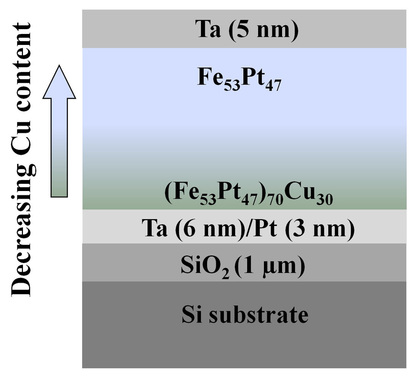Graded Anisotropy

Graded anisotropy (Ku) [1] materials are one possible solution to the magnetic recording “trilemma” where the thermal stability, writability, and signal-to-noise ratio must be simultaneously balanced for successful long-term storage. In graded-Ku materials the low-Ku layers act to reduce the writing field while the high-Ku layers preserve thermal stability. The approach primarily pursued by our group [2] relies on the fabrication of continuously graded FePtCu single films where we take advantage of the strong dependence of the low-Ku A1 phase to the high-Ku L10 ordering temperature in compositionally graded (Fe53Pt47)100−xCux ( x=0–30). The Ku-gradient is then established after proper post-annealing. In addition to conventional magnetometry, subsequent characterization is then carried out using the magneto-optical Kerr effect (MOKE) [3], first-order reversal curves (FORCs) [4], and polarized neutron reflectivity (PNR) [5].
[1] D. Suess, Appl. Phys. Lett. 89, 113105 (2006).
[2] C. L. Zha, et al., Appl. Phys. Lett. 97, 182504 (2010).
[3] V. Bonanni, et al., Appl. Phys. Lett. 97, 202501 (2010).
[4] R.K. Dumas et al., IEEE Trans. Magn. 47, 1580 (2011).
[5] R. K. Dumas, et al., Phys. Rev. B 84, 054434 (2011).
[1] D. Suess, Appl. Phys. Lett. 89, 113105 (2006).
[2] C. L. Zha, et al., Appl. Phys. Lett. 97, 182504 (2010).
[3] V. Bonanni, et al., Appl. Phys. Lett. 97, 202501 (2010).
[4] R.K. Dumas et al., IEEE Trans. Magn. 47, 1580 (2011).
[5] R. K. Dumas, et al., Phys. Rev. B 84, 054434 (2011).